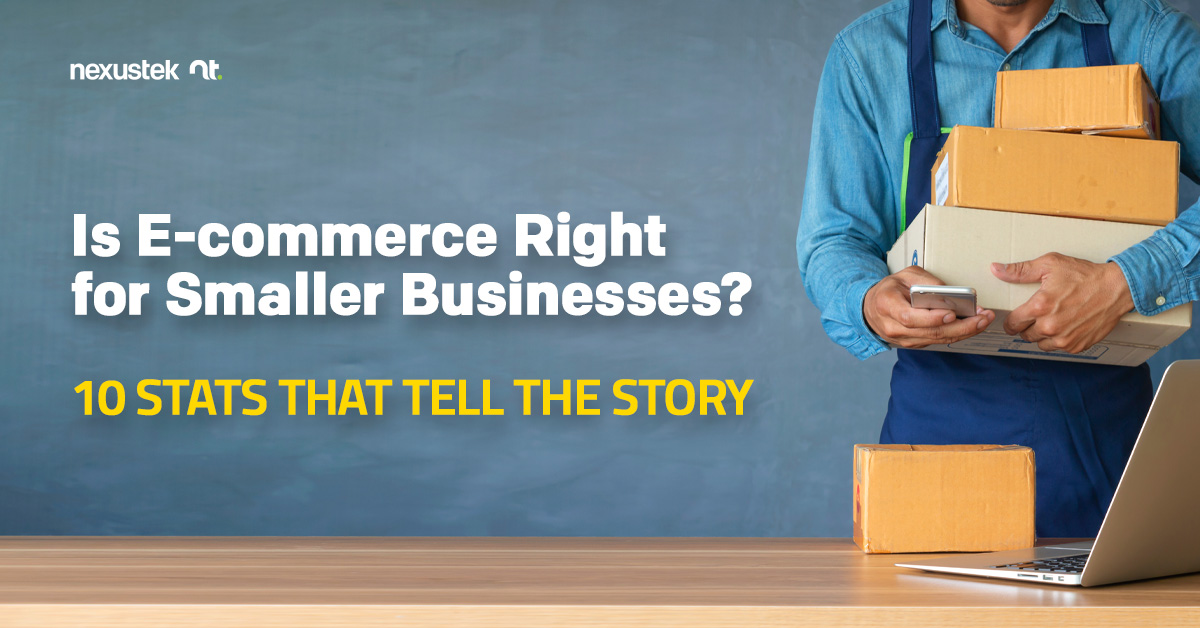1/3
Let’s start with an overview. Currently, over one third of SMBs have not set up any type of e-commerce platform1. This places these businesses at a disadvantage if their competitors offer online sales options (which they probably do).
READ TIME: 4 MIN

A nearly universal aim among smaller businesses is to become…well, less small. The question of how to expand market reach and find new customers is on the minds of most leaders of small and medium-sized businesses (SMBs), and the prospect of branching out into e-commerce can be tempting.
But is e-commerce really a good move for SMBs? It’s a reasonable question, which is why we’ve put together this “story in stats” to shed light on e-commerce’s place in the small business world. And spoiler alert…for SMBs who are considering adding online sales to their repertoire, the story has a happy ending!
Let’s start with an overview. Currently, over one third of SMBs have not set up any type of e-commerce platform1. This places these businesses at a disadvantage if their competitors offer online sales options (which they probably do).
To understand the magnitude of the advantage SMBs gain when they adjust their business models to include e-commerce options, think about this stat: In the last 10 years, the portion of U.S. retail sales commanded by e-commerce has TRIPLED. Specifically, online sales accounted for about 5% of all U.S. retail sales in 2013, but now they account for about 15%2. With younger generations opting for e-shopping at higher rates than older generations, it’s logical to expect this upward trend to continue.
On the flip side, to understand the disadvantage experienced by companies that don’t offer e-commerce options, consider this statistic: 40% of buyers will not purchase items or services from a company that doesn’t offer their preferred channel3. That means you could lose out on a huge chunk of potential customers simply because you don’t offer their preferred buying channels.
And what are those most preferred channels? A whopping 64% of customers reported a distinct preference for ordering online and picking up in-store4. A slightly smaller proportion (55%) reported a preference for either fully online buying or hybrid (i.e., combination of in-store and online). So for SMBs wondering how to position themselves to reach as many customers as possible, the take-home here is that having both in-store and e-commerce options is advantageous.
Now, you may be reasonably wondering if e-commerce will increase your total revenue, or if it will simply cannibalize your brick-and-mortar sales. The encouraging news is that for brick-and-mortar operations that added an e-commerce option, their online channel generated a 28% increase in revenue overall5.
But wait, it gets even better! Adding an e-commerce option not only generates additional revenue through online purchases—it can also increase your in-store sales. Remember how we mentioned above the 64% of buyers prefer to purchase online but pick up in-store? Well, those buyers often find additional items they want to purchase once they enter the store. A Google study found that 85% of buyers make additional in-store purchases when picking up their online orders6.
Once a business makes the plunge into the e-commerce realm, some new questions arise. You may already know that customer experience is the key to success, but how do you enhance online customer experience? In short, website speed. One study revealed that a 0.1 second improvement in site speed was associated with a 9.2% increase in order value7.
On the other hand, a slow website may portend disappointing outcomes for SMBs who adopt e-commerce. One study revealed that 79% of customers would be less likely to make a repeat purchase from an online site if they felt dissatisfied with its speed8. This is one reason why hosting your e-commerce platform with a cloud provider makes sense. You avoid any latency issues that may crop up with on-premises infrastructure, and the scalability of the cloud allows your platform to handle surges in traffic and purchases.
Even with good site speed, you still face the unpleasant reality of shopping cart abandonment. One study found that 63% of customers abandon carts if shipping is too expensive, while 36% do so if shipping takes too long9. Whether partnering with a third-party fulfillment company or managing shipping internally, automating workflows following order submission helps to increase efficiency and reduce labor costs associated with order fulfillment.
Customers may also abandon carts if personal information they entered previously has not been stored in the online purchase platform. When faced with having to re-enter credit card information, 30% of online buyers will abandon carts, and 25% do the same if asked to re-enter their shipping information10. For SMBs wishing to enhance customer experience by storing this type of sensitive data, consulting with a cybersecurity expert first is a must.
The story told by the last few stats (aka, “How to Lose Online Customers”) may have left you wondering what happened to the “happy ending” that we promised for this story. The silver lining is that developing a solid underlying infrastructure for your e-commerce operations can help you to create the positive shopping experience that attracts customers and keeps them coming back.
Offering both cloud hosting, managed IT, and cybersecurity services, NexusTek assists SMBs to create, manage, and secure the IT infrastructure needed to support top-of-the-line e-commerce operations.
Interested in exploring how to create a powerful infrastructure for your e-commerce platform?
References: